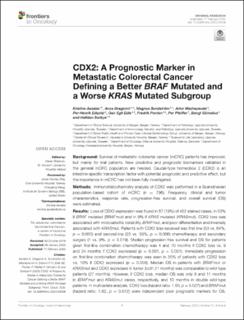| dc.description.abstract | Background: Survival of metastatic colorectal cancer (mCRC) patients has improved, but mainly for trial patients. New predictive and prognostic biomarkers validated in the general mCRC population are needed. Caudal-type homeobox 2 (CDX2) is an intestine-specific transcription factor with potential prognostic and predictive effect, but the importance in mCRC has not been fully investigated.
Methods: Immunohistochemistry analysis of CDX2 was performed in a Scandinavian population-based cohort of mCRC (n = 796). Frequency, clinical and tumor characteristics, response rate, progression-free survival, and overall survival (OS) were estimated.
Results: Loss of CDX2 expression was found in 87 (19%) of 452 stained cases, in 53% if BRAF mutated (BRAFmut) and in 9% if KRAS mutated (KRASmut). CDX2 loss was associated with microsatellite instability, BRAFmut, and poor differentiation and inversely associated with KRASmut. Patients with CDX2 loss received less first-line (53 vs. 64%, p = 0.050) and second-line (23 vs. 39%, p = 0.006) chemotherapy and secondary surgery (1 vs. 9%, p = 0.019). Median progression-free survival and OS for patients given first-line combination chemotherapy was 4 and 10 months if CDX2 loss vs. 9 and 24 months if CDX2 expressed (p = 0.001, p < 0.001). Immediate progression on first-line combination chemotherapy was seen in 35% of patients with CDX2 loss vs. 10% if CDX2 expressed (p = 0.003). Median OS in patients with BRAFmut or KRASmut and CDX2 expressed in tumor (both 21 months) was comparable to wild-type patients (27 months). However, if CDX2 loss, median OS was only 8 and 11 months in BRAFmut and KRASmut cases, respectively, and 10 months in double wild-type patients. In multivariate analysis, CDX2 loss (hazard ratio: 1.50, p = 0.027) and BRAFmut (hazard ratio: 1.62, p = 0.012) were independent poor prognostic markers for OS.
Conclusion: In a population-based cohort of mCRC patients, CDX2 loss is an independent poor prognostic marker. Expression of CDX2 defines a new subgroup of BRAFmut cases with a much better prognosis. Loss of CDX2 defines a small group of KRASmut cases with a worse prognosis. Patients with CDX2 loss receive less palliative chemotherapy with less benefit and rarely reach secondary surgery. | en_US |

